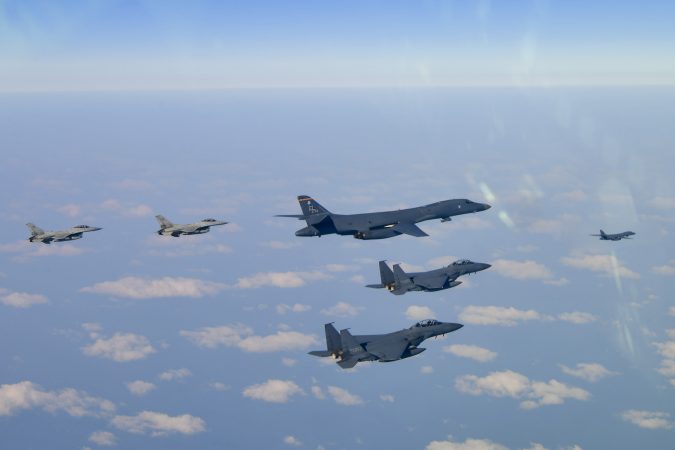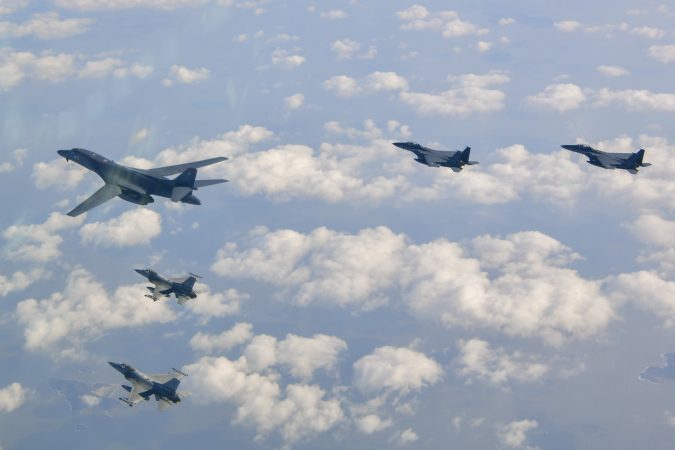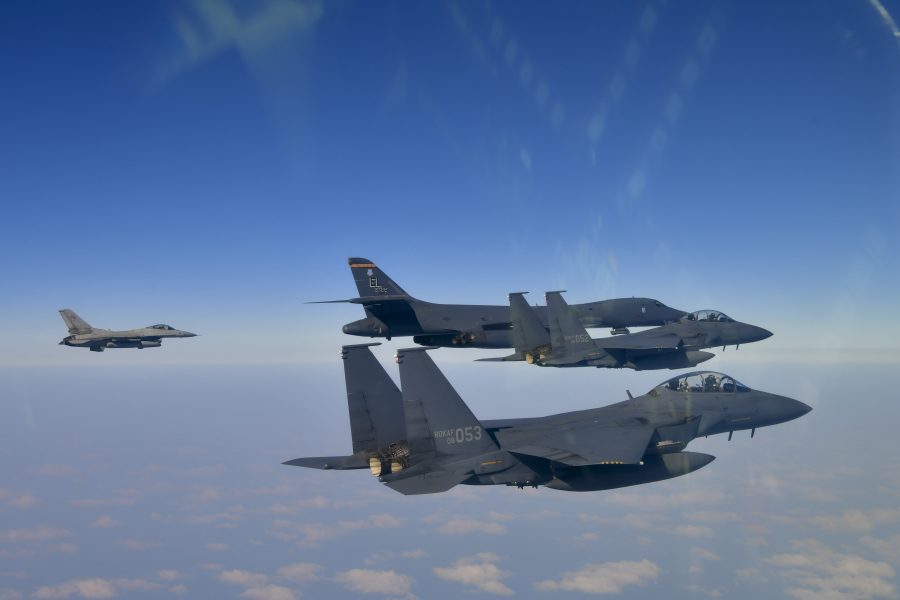Two U.S. Air Force B-1 bombers led a joint aerial exercise between the U.S. and South Korea over Korean airspace on Feb. 20, as officials emphasized the importance of training to counter the likes of North Korea.
The Lancers were joined by three USAF F-16s, four U.S. Marine Corps F-35Bs, four Republic of Korea Air Force F-35As, and two of their F-15Ks, for simulated precision strike and air defense training, according to a release. The F-16s came from the 51st Fighter Wing at Osan Air Base, South Korea, while the Marine Corps fighters came from the 1st Marine Aircraft Wing at Marine Corps Air Station Iwakuni, located in southern Japan. The long-range bombers, from Ellsworth Air Force Base, S.D., have been stationed at Andersen Air Force Base in Guam since last month.
“Advanced training like today’s event ensures we’re able to maintain the high levels of readiness necessary for our combined defense posture,” said Lt. Gen. David R. Iverson, Seventh Air Force commander, in the release. “Each time our aircrew plan, execute and debrief together, we build proficiency in our tactics, techniques and procedures to defend the Alliance, if required.”
The South Korean Ministry of National Defense said the training was conducted to “demonstrate the U.S.’s extended deterrence capability against North Korea’s growing nuclear and missile threats, and to bolster the interoperability of the South Korea-U.S. combined forces.”
Maj. Gen. Jason R. Armagost, head of the 8th Air Force that oversees the U.S. bomber fleet, likewise said in a Feb. 19 press conference that the U.S. and South Korea will continue to train on how to integrate nuclear and conventional forces while keeping a close eye on North Korea.
“All the way from competition activities through crisis and conflict, that relationship of working together, planning together, and operating militarily together is an extremely powerful thing to practice and to conduct,” said Armagost.

The B-1s flew from Guam into South Korean airspace, escorted in by ROK Air Force F-15K Slam Eagles. Following State Department approval in November, the F-15K fleet is set for a major $6.2 billion upgrade, including advanced mission computers, radar systems capable of tracking targets at long distances, missile warning systems, along with spare parts and technical support.
The Air Force deployed four Lancers from Ellsworth to Anderson on Jan. 15 for the first Bomber Task Force of 2025. Two of those B-1s participated in a trilateral flight with two ROK Air Force F-15Ks and two Japanese Air Self-Defense Force F-2s on the same day, flying in the airspace between Japan and South Korea before landing in Guam.
The three nations held their first-ever trilateral air exercise in October 2023 and have since flown together three more times, each time with American bombers accompanied by some combination of Japanese, American, or South Korean fighters. The growing ties between the three countries were highlighted by a trilateral summit between the nations’ political leaders in August 2023, where they agreed to conduct more annual exercises.
Since then, however, all three countries have experienced political change: Japanese Prime Minister Fumio Kishida stepped down in October, South Korean President Yoon Suk Yeol was impeached over a martial law declaration, and new U.S. President Donald Trump canceled exercises with South Korea in his first term, claiming they were too expensive and pushing both Seoul and Tokyo to increase payments to support the U.S. military presence in their countries. It remains to be seen how these recent shakeups will affect future military exercises.

